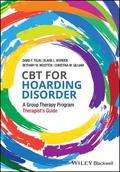CBT for Hoarding Disorder
A Group Therapy Program Therapist's Guide

1. Auflage September 2017
200 Seiten, Softcover
Wiley & Sons Ltd
Kurzbeschreibung
Comprised of a therapist manual and client workbook, CBT for Hoarding Disorder guides group leaders through a comprehensive CBT group program for patients with hoarding disorder (HD). The therapist manual provides step-by-step, evidence-based guidance for treating HD with a focus on proven methods for behavior change rather than complex cognitive interventions. The client workbook features accessible, straightforward content, including coping cards that summarize key lessons, homework assignments, motivational tools, and practice exercises for decision-making and emotion regulation skills.
Part of a two-component product with a companion client workbook, CBT for Hoarding Disorder: Therapist's Guide guides group leaders through a comprehensive CBT group program for patients struggling with hoarding disorder.
* Provides step-by-step, evidence-based guidance for treating hoarding disorder (HD) with a focus on proven methods for behavior change rather than complex cognitive interventions
* Contains the latest research on HD and emphasizes the cognitive, emotional, and motivational factors involved in discarding and decision-making
* Features an accessible, straightforward client workbook with coping cards that summarize key lessons, homework assignments, motivational tools, and practice exercises for decision-making and emotion regulation skills
* Easy to implement without home visits for professionals and group leaders of all educational backgrounds across a wide variety of treatment settings and disciplines
What is Hoarding Disorder? 3
Diagnosing Hoarding Disorder 3
What Causes Hoarding Disorder? 7
How Do We Target These Factors in Treatment? 12
Implementing Group CBT for Hoarding Disorder 18
Does This Treatment Work? 18
What Does the Group Look Like? 20
Who Is This Group Designed For? 24
Use of the Manual 25
Troubleshooting Common Problems 26
Measuring Outcomes 31
Part II Treatment Manual 33
1 Welcome to the Class 35
1. Welcome to the Declutter Class 38
2. Class Rules and Guidelines 42
3. What is Hoarding Disorder? 46
4. What Will I Learn in This Class? 47
5. How Well Does the Declutter Class Work? 48
6. Homework 49
2 Why Do I Have So Much Stuff? 54
1. Homework Review 57
2. Rewards 58
3. Meet the "Bad Guys" 60
4. Setting Goals 66
5. Homework 68
3 Making Decisions and Solving Problems: Part 1 71
1. Homework Review 73
2. Making Decisions and Solving Problems 74
3. Making Decisions and Minimizing Distractions 75
4. Making Decisions and Improving Organization 81
5. Putting Skills Together to Discard Better 84
6. Homework 85
4 Making Decisions and Solving Problems: Part 2 86
1. Homework Review 87
2. Making Decisions: Acquiring 88
3. Solving Problems 92
4. Discarding Practice 96
5. "Bad Guy" Re?]evaluation 96
6. Homework 97
5 Intense Emotions: Part 1 98
1. Homework Review 99
2. About Intense Emotions 100
3. Tackling Intense Emotions That Lead to Acquiring 104
4. Homework 106
6 Intense Emotions: Part 2 108
1. Homework Review 109
2. Tackling Intense Emotions That Get in the Way of Discarding 109
3. "Bad Guy" Re?]evaluation 114
4. Homework 115
7 Unhelpful Thinking: Part 1 118
1. Homework Review 119
2. How Thoughts Influence Emotions 119
3. Identifying Unhelpful Thoughts 121
4. Homework 124
8 Unhelpful Thinking: Part 2 126
1. Homework Review 127
2. Tackling Unhelpful Thoughts 128
3. "Bad Guy" Re?]evaluation 131
4. Homework 132
9 Waxing and Waning Motivation: Part 1 133
1. Homework Review 134
2. Improving Motivation 134
3. Acting on Your Top Goals and Values 136
4. Homework 139
10 Waxing and Waning Motivation: Part 2 142
1. Homework Review 143
2. Improving Motivation to Discard 144
3. Being Motivated By Your Values 145
4. Checking In on Long?]Term SMART Goals 146
5. "Bad Guy" Re?]evaluation 146
6. Homework 147
11 Putting It All Together: Part 1 148
1. Homework Review 149
2. Troubleshooting Common Barriers 150
3. Putting It All Together 151
4. Homework 153
12 Putting It All Together: Part 2 154
1. Homework Review 155
2. Troubleshooting Common Barriers 155
3. Putting It All Together 158
4. Homework 159
13 Putting It All Together: Part 3 160
1. Homework Review 161
2. Troubleshooting Common Barriers 162
3. Putting It All Together 163
4. Homework 164
14 Putting It All Together: Part 4 165
1. Homework Review 166
2. Troubleshooting Common Barriers 167
3. Putting It All Together 168
4. Homework 169
15 Staying Clutter Free in the Future: Part 1 170
1. Homework Review 171
2. Reviewing Progress 172
3. Practice Discarding 174
4. Homework 174
16 Staying Clutter Free in the Future: Part 2 176
1. Homework Review 177
2. Maintaining Motivation 177
3. Wrap?]Up and Questions 179
Appendix A: Clock Sign 180
Appendix B: "Bad Guy" Reminder Cards for Participants 181
References 183
Index 190
Blaise Worden is a clinical psychologist at the Anxiety Disorders Center/Center for Cognitive Behavioral Therapy The Institute of Living, USA, where she runs and directs cognitive-behavioral treatment groups for hoarding disorder. She has co-authored book chapters on the phenomenology of both hoarding and obsessive-compulsive disorder, and provides educational talks to community organizations about HD treatment.
Bethany M. Wootton is a clinical psychologist and Senior Lecturer in Clinical Psychology at the University of New England, Australia. She has an interest in the treatment of anxiety and related disorders. Her research focuses on the development and evaluation of remote treatments in order to improve access to evidence-based treatments for these conditions. Christina Gilliam is a clinical psychologist and Director of Educational Programs at the Anxiety Disorders Center/Center for Cognitive Behavioral Therapy at the Institute of Living, USA. She is an expert in providing and training others in cognitive behavioral therapy for anxiety disorders, obsessive compulsive and related disorders, and she has published journal articles and book chapters in these areas.


